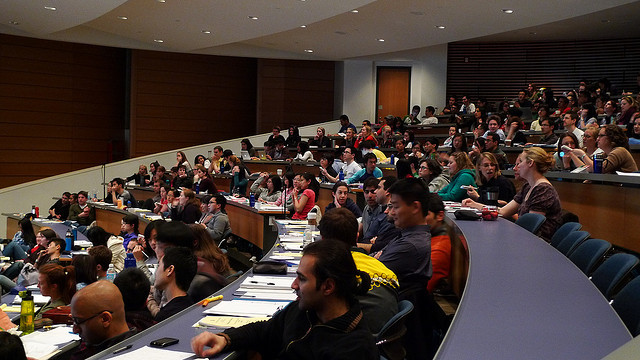Philadelphia school and city officials say the district will be forced to lay off teachers and possibly grow class sizes as large as 40 when students return in September, unless the state and city gives it more money.
But the district’s numbers don’t seem to add up.
With 8,390 teachers and 142,000 students, the Philadelphia School District has a teacher-to-student ratio that is almost identical to the national average. But the district’s superintendent has suggested class sizes in Philadelphia schools are significantly larger than the national average, and could soon grow larger still.
So where are all Philadelphia’s teachers? And why can’t the district avoid putting 40 students in a single classroom?
The district didn’t return multiple calls and emails asking those questions.
Survey the Numbers
Here’s what we do know, based on the numbers.
The school district adopted a 2014-15 budget in July that includes a $93 million funding gap. Unless it finds more money somewhere, the district might have to lay off 1,300 workers.
Philadelphia Mayor Michael Nutter has pressed lawmakers in Harrisburg to pass a citywide $2-per-pack cigarette tax to help fund the school district. Without the tax, he told the Philadelphia Inquirer, class sizes could swell to 40 students next year because of layoffs.
It’s unclear how those layoffs would result in class sizes that large. Philadelphia’s student-to-teacher ratio is about 16-to-1, according to numbers the district reported to the state’s Department of Education. That almost mirrors the national average, which is about 17-to-1, according to research conducted by Matt Chingos, senior fellow at the Brown Center for Education Policy at the Brookings Institution, a think tank. Chingos’ research shows a relationship between teacher-to-student ratio and class size.
It’s not an exact match—teachers need time for prep and breaks, so a ratio of 17-to-1 doesn’t translate to class sizes of 17 students.
Chingos has tracked student-to-teacher ratios and class sizes in American public schools since the 1960s. The numbers have varied a bit, but in recent years an average ratio of 17-to-1 has roughly translated to an average class size of 22 for elementary schools and 26 for high schools.
“Lots of people are called teachers in schools that aren’t really handling classrooms, but doing a variety of other things,” said Eric Hanushek, a fellow at Stanford University’s Hoover Institution. “It’s always hard to know what class size means, because is it the P.E. class or the English class or the math class? There’s usually a lot of variation even within the school.”
Data from the National Center for Education Statistics seem to agree with Chingos’ research—and again shows Philadelphia to be an outlier on class size, even though it’s not an outlier in terms of student-to-teacher ratio.
Fuzzy Local Reports
In Philadelphia, it’s hard to pin down an exact number for the average class size. The district didn’t say whether it has a target class size, or whether it even knows what the average class size was last year—although a contract with the teachers union stipulates that schools work toward class sizes of about 25 students.
A teachers union spokesman said class sizes likely exceeded contractual agreements of 30 students in kindergarten through third grade and 33 students in higher grades.
“We’ve heard reports of much more than that in the classroom this year,” said George Jackson, communications director for the Philadelphia Federation of Teachers.
If the district were to lay off 1,300 workers, one could assume a “worst-case” scenario, where all the layoffs are full-time classroom teachers. But even then, the numbers don’t seem to work.
That would leave the district with about 7,000 teachers, bringing the ratio to about 20-to-1. Although that is higher than the national average, it’s not dramatically higher, and classes of 40 students or more seem unlikely.
Assuming one teacher per classroom, those numbers indicate that during an average class period, half the teachers employed by the district are not teaching. (The district didn’t say how many of its teachers were aides or taught smaller special education, or otherwise would have affected the ratio.)
These figures give the school district the benefit of the doubt, since we’re using enrollment numbers instead of actual student attendance. Looking at attendance figures would produce a lower teacher-to-student ratio and also lower average class sizes.
Still, the district’s talking point about 40 students in a classroom has become a fixture in debates over the cigarette tax and school funding.
It likely won’t come to that. If classrooms will have that many kids in them, district superintendent William Hite says he won’t open the schools at all this September.
Avoiding an Explanation
Fernando Gallard, the district’s spokesman, spoke with a reporter who wanted to send questions via email. Gallard gave his email address, and after emailing him, the reporter has not heard from him, despite multiple phone calls. The district’s phone line often went to voice mail and couldn’t receive new messages; when a receptionist answered, the reporter was told Gallard was constantly in meetings and would surely respond. He hasn’t.
“Unless he’s on vacation or something,” Jackson said of Gallard, “he’s a good guy, generally pretty responsive.”
Eric Boehm ([email protected]) and Mary Tillotson ([email protected]) are reporters for Watchdog.org. Reprinted with permission. Image by velcr0.




